- NEW DVD Series – Stone Setting with Bezels
- Tube Set Charm by Kim St. Jean
- Prong Basket Pendant by Kim St. Jean
- NEW DVD Series – Stone Setting with Cold Connections
- New DVD Series – Stone Setting with Wire
- NEW DVD Series: Introduction to Stone Setting by Kim St. Jean
- Featured Tool: Bracelet Bending Plier
- NEW Dvd by Eva Sherman
- Fun, Fast Fold Forming DVD Series
- Double Band Ear Cuff from Alex Simkin
Take Photos of your Wire Jewelry using a Lightbox – Part 1
by Mike Ault
So you’ve designed and made an absolutely gorgeous piece of wire jewelry and want to get it on your website as soon as possible so it can be seen and generate sales. You take your camera, place the piece carefully on a neutral background, hold your breath, carefully snap a picture, only to have it turn out amateur looking at best. What can you do?
Professional product photographers use what is known as a light box to control their light and exposure for product shoots. You, as a wire jewelry maker can also take advantage of these techniques. Light boxes can be made from white milk jugs, cardboard boxes or other containers. Or, you could go out and spend anywhere from $60-1000 USD for a pre-made one. In this tip I want to show you how to make one from readily available materials that will last, be portable and produce professional looking results.
A light box is a container with light reflective sides, usually white. The floor of the light box is usually covered with either white or colored paper or fabric. Some photographers use a roll of paper so when it gets soiled, they can easily replace it.
To build your own light box all you need is time, 5 sheets of 20X30 white foam board, a marker, a ruler, a cutting surface and two 500 watt work lights. A straight edge such as a steel ruler is handy to make sure your cuts are straight.
To begin, view the diagram to see how to mark your foam boards. You will need 1 each for the top, bottom, sides and back. Follow the measurements carefully, slight overcuts probably will not affect the result. Make sure you use a sharp razor or Exacto knife to do the cutting and make sure you keep fingers, arms, legs and bodies out of the way.
The slots shown only have to be wide enough to accept the edge of the foam boards. Too large and things will be shaky, too small and it will be tough getting them together.
I suggest keeping the foam cut-outs for the top’s light port and shooting port as when these are not in use you will want to insert them back in place. Also keep two of the narrow cut pieces from one of the sides, you will need 2, 1 inch by 6 inch pieces later.
Once every thing is cut out, carefully piece it together. If you have measured and cut carefully it should form a hollow box about 30 inches wide and 20 deep and 20 tall. For covers for the light ports when in use (to soften the harsh light from the work lights) I use light-weight white cotton fabric attached using Velcro. Others have bought frosted or cracked glass to cover the light ports.
I suggest using a 8 x 10 piece of glass from a picture frame (just the glass is available at a hardware store in pre-cut sizes) and the 1 inch x 6 inch strips to provide a stage to set your jewelry on. This gives the picture depth.
Next post will be a continuation of this – discussing how to use the lightbox! – Click Here for Part 2!






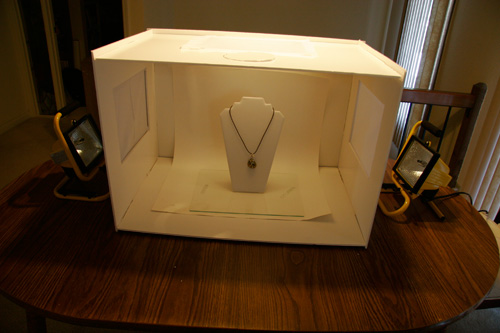
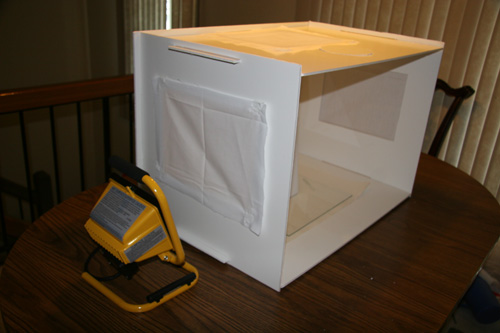

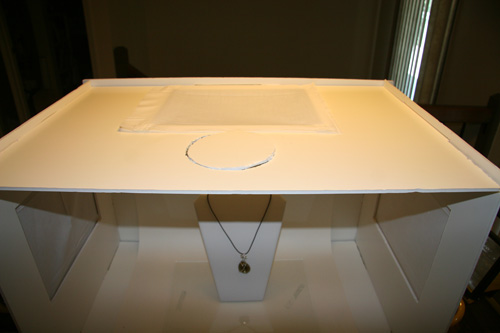
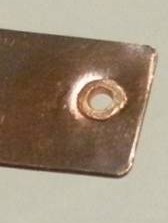
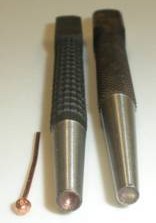

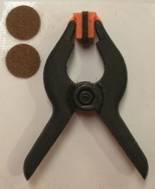

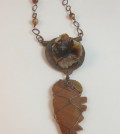




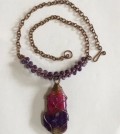


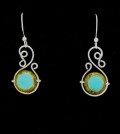




mary bailey
September 23, 2009 at 12:05 pm
Great article but can we not have a printer friendly page to print out and save? This would be very helpful to put into a notebook for later reference and use.
Thanks!
Jackie Woodward
April 24, 2012 at 8:33 pm
Hi Mary if you have a PC all you have to do is open a Microsoft office new page and select the info you want to copy. to do that select it( it will turn dark) hold down to bottom of info all should be dark you want to print and select ctrl C go to new page and select the top of it and select ctrl V that will paste info onto your new page then save it to a jewelry folder if you want to keep it or print the page.
Vicki Miller
September 23, 2009 at 12:39 pm
Thank you for sharing such a great & money saving idea.
Subasdesigns
September 23, 2009 at 12:44 pm
Could you please include a picture of the finished lightbox? That would be great! Thanks.
helen crisman
September 23, 2009 at 1:32 pm
this sounds great, but a photo of each step would be much nicer to see the construction and set up in progression. perhaps yopu could add that. seeing is believing.
Beatriz
September 23, 2009 at 3:32 pm
Thank you very much, it’s a wonderful idea to publish this article helps those who take care of handmade jewelry, make better photos with our pieces.
I have this problem, the pictures of my jewelry look dark or very bright and can not appreciate my work. Thanks again. From Caracas, Venezuela.
gAIL
January 6, 2016 at 4:35 pm
Download Picasa free and you can fix your photos
Ethel White
September 23, 2009 at 4:11 pm
Can you tell me where I can find the 500 watt work lights that you mentioned in your instructions? Thanks for the instructions. I tried to make one with a plastic crate. It helps but needs to be better. I think this one will do a much better job. I appreciate you sharing.
Sincerely, Ethel White
Carol Fussell
September 23, 2009 at 5:32 pm
This is a great idea but I wish there was a video showing the process (or at least a few photographs along the way, including one of the finished white box being used), to get a sense of not only how the lights need to be set up to shine through the ports, but also how to use the 1 x 6 inch strips to create the depth in the photo. And why, if the lighting is so critical, would the front be completely open? Should the photo always be taken through the camera port, or would it be acceptable to shoot through the open front? I’m assuming that the flash on the camera should be supressed (turned off) when using this light booth? Thanks!
Marilyn sue Czarnecki
September 23, 2009 at 5:37 pm
I have a problem taking the right pictures. Mostly rings, sparkly pins, silver,& Gold. This is a great idea.
Barbara Ellis
September 23, 2009 at 5:45 pm
Great information. I’ve been trying for a couple of year to get a satisfactory setting for photographing my jewelry. I can’t wait to make one of these. Thanks!
Pat Todd
September 23, 2009 at 6:07 pm
Thanks for the detailed instructions and advice! I’ll try it right away. Thanks, Pat
Trish
September 23, 2009 at 8:43 pm
This is awesome. Thank you so much. I was wondering what to do when it turns 20 below outside this winter!
Cheryl Chrabaszcz
September 24, 2009 at 12:18 am
Thank you for this advice, taking pictures of my pieces has been most difficult for me. I’m not sure how this box will help me. I have been experiencing that my camera produces too much light when taking pictures of my jewelry. I’m eagerly awaiting your next article to get a better understanding of how this box is used. Again thank you for this idea.
Cheryl Chrabaszcz
Ellen Pridemore
September 24, 2009 at 8:47 am
Ditto on the need for a printer friendly page!! I would need a good copy of the instructions right with me while I work! I made a lightbox once from a cardboard box and parchment paper. It helped but was awkward and unsightly. This one sounds neat. So, could we use parchment paper over the light port instead of fabric? Thanks for a good idea. I will be waiting for part 2!
Jean Hill
September 24, 2009 at 10:46 am
Step by step photos would be very helpful as well as views of using the box. Thanks!
Bernice
September 25, 2009 at 10:55 am
I also need the instructions with me when I’m putting it all together; so I highlighted the article, hit “Control C” to copy and pasted it into Word (almost any word processor would do) then printed it out. Hope that helps.
Bernice
September 25, 2009 at 10:57 am
Work lights are available at Home Depot, Lowe’s, etc.
tracey
September 25, 2009 at 1:23 pm
500 watt work lights get too hot and use up to much electricity, i use daylight bulbs not hot and very bright
Cynthia House-Peters
September 25, 2009 at 8:56 pm
I just started taking pictures of my jewelry today and was NOT pleased with the end result, so was delighted when I picked up your tip e-mail from yesterday(?) regarding this very subject. Of course I went looking for part 1 after reading part 2. I will build the light box and hope for better results. Thanks for all of your tips as they make wire working so much easier.
Karol
September 26, 2009 at 9:06 am
I have an add on from mozilla for firefox called \"screengrab\" it will take a copy what I want like a portion of the page, very handy for later and learning. This site rocks…Thanks, you have made me a better artist, I am still learning and have 2 kinds of arthritis but making jewelry and other things keeps me going.
Ellen Wahi
September 27, 2009 at 7:59 pm
Would you please give placement and size measurements for the light ports and camera port?
Thanks
Ellen
Jim Juris
September 29, 2009 at 3:22 pm
Here is a link for making a foam core lightbox. It is very easy to make and only requires 3 pieces of foam core board.
http://www.inexpensivejewelryphotography.com/photolightbox.html
Diana Lambson
September 29, 2009 at 7:31 pm
Making a printer-friendly copy is not difficult.
Block entire document by clicking on the first line then hold down the left mouse key and pull the blocking color all the way down the document.
Using right cursor, click within confines of blocked document and select copy.
Minimize blocked document.
Open a new document in your word processor. The cursor should appear as if you are going to create a word file.
Using left mouse button, click inside new document, select paste. It may take a minute but the copied document, including diagrams, should be transferred to the new document.
Once this is done, print the document. You will not have all the extra ads and comments to worry about. You might also want to save the copied document for future reference.
Hope this helps. Peace and God Bless, Diana L.
MIke Ault
September 30, 2009 at 12:47 pm
Parchement paper would work, anything that will soften the worklight to white. Lower wattage bulbs in the softwhite may work as well, but then you may need to play with the color temperature setting. There are photos of the finished box in part 2. As for the stage, just place the strips at the edges of the glass to lift it about a 1/4 inch and then place the pieces on the stage that is formed.
For top shots I use the round port on top, for side I shoot from the front. You don’t need all four sides covered, the three sides gives great control. Some folks put a flash in the top port with a soft box or diffuser head on it.
Mike
Lyn
October 9, 2009 at 2:09 am
I read somewhere you could cut a portion out of a 1 gallon milk bottle, put a piece of paper curling around the inside to photograph small pendants or earrings. ( I cut some slots at the top of the paper for hanging) I use a sunny spot for lighting, it dose diffuse the light and cuts out excessive reflection.
Cam Lamatrice
October 15, 2009 at 7:48 pm
I was wondering when I can expect part 2 of lightbox? Also could you make it printer friendly?
Trish Towley
October 31, 2009 at 2:14 pm
I think it’s pretty tacky of Jim Juris to post his own website here, selling his e-book telling you how to do the same thing that Brandon’s website, Wire-Sculpture.com is sharing with you without cost.
Mike
November 4, 2009 at 9:03 pm
Here is the link to part 2!
http://wire-sculpture.com/jewelry-making-blog/?p=289
Kenneth
November 8, 2009 at 11:44 am
The William Holland School at Young Harris, GA. has a Photography
course on Photographing Jewelry that is a week long solely on Jewelry, The course supplies a light box a pair of reflectors and 6500 daylite bulbs included in the class fee.
Boni
December 14, 2009 at 4:46 pm
Thanks so much for sharing. This is just the type of information needed by any jewelry maker. I want to share some inexpensive lighting that has worked for me. I hope you won’t mind. Thanks again.
I have made a light box and bought a light tent from Table Top. The one from Table Top is easier to use and store. Just my opinion. I bought 3 brushed stainless steel looking desk lamps with ‘goosenecks’, $8 each at WalMart. They are very stable lamps, and very versatile. (I would not recommend the type that clips to a desk, get the one that sits on a desk. Just my opinion.) I bought the ‘Daylight’ floursent coil looking light bulbs from Loews. And, I bought(from a local grocery store on sale for $6) a Lights of America brand Decor LED Accent Light Bulb, 1.5 watt, Bright White LED /DayLight bulb-a ~14 LED light bulb that fits one of the lamps. The floursent bulbs light the sides, and the LED light lights from the front for extra sparkle. I set my lighting setting on my Canon SX20 IS to flouresent. I always use a tripod and set timer for 2 second delay. These things are just what I have found to make some extremely significant improvements in my photos. Your results may vary. Good luck.
Melissa Gemmel
March 4, 2010 at 8:29 pm
Thanks for this article! Have been photographing jewelry and gem stones for several years. I have several commercial light boxes, and 2 I have made. Anything that diffuses direct light is important – shadows are mostly eliminated. As far as glass goes, I use the non-glare type or a mirror, depending on the desired results.
Use of small mirrors (or broken mirror pieces) in the box area is interesting, as it can either help focus the light, or scatter it. I use various materials for a background — paper, textiles, photos, just experiment! Even add fake flowers and curled ribbons if you like.
As far a lighting goes, I highly recommend halogens and LED lights. These are “cool” and seem to keep the colors very natural. I purchased 3 LED table lamps at Target, but you can get them at Lowes, Home Depot, etc. Check the online stores for supplies first, and save yourself the agony of wandering the city.
An excellent trick to shooting close is to add close-up lenses to your standard lens. If your camera lens has a “filter screw ring” at the very front, you can screw on Close Up lenses in +1, +2, etc versions. And, you can use any combination of these together too. A 3 lens set is about $25.
Adra E
April 22, 2010 at 1:56 pm
Mike you’re the man. . . this is certainly a well need tool. I have wanted to build one of these for months, I’ve purchased the foam core, and cut one of them up but did not make it large enough. Thank you so much for this post. God bless you. Keep it coming.
Carolyn
April 24, 2010 at 6:53 am
Awesome! Thank you for this article! I am SO tired of crappy photos! I can’t wait to give this a try. Thank you, thank you, thank you.
haydee
July 28, 2010 at 10:18 am
thank you sooo much for all the great ideas you share—this light-box is great, can’t wait to try it—thanks again,
Haydee.
Ruth Soucek
August 14, 2010 at 9:13 am
Dear Mike,
this light box is super. I used something simular, but not quite as thought out. I used a collapsable carry bag with the rigid top and layed it on it’s side.
If you go to my website you will see that I do Miniature
Water colors and Porcelain painting as well as jewelry. Photographing Porcelain is very tricky because of all the glare.
This box, with the light ports and the option to filter the light, will cut down on the glare.
Thanks for sharing this with us.
Ruth Soucek
Pingback: Tonja's Polyclay Corner » Blog Archive » Build Your Own Photography Light Box
Brandi
October 1, 2010 at 5:02 pm
What an amazing tutorial. I really needed this tip. Thanks alot.
Pingback: Photographing Your Wire Jewelry | Jewelry Making Instructions
Tina
February 2, 2011 at 8:56 am
This might be EXACTLY what I need. I make my own jewelry and have set up a basic website where I can hopefully sell my products online. The problem is the pictures just don’t look professional like the sites of Pandora and other big outfits. I will be going to the store right now! Thanks, and I think I will be reading the rest of your articles over the coming days!
Tina
Donna
March 27, 2011 at 8:30 am
Wonderful article! I built my lightbox with a similar type of design, but taped it together instead of having removable tabs. In order to save my tissue paper (from my cat), I made removable light panels which I attach with velcro. I also attach the “ramp” of posterboard on the back with velcro to keep it in place.
One tip I read was to use an acrylic photo frame as a simple platform if you want to lay pieces flat to give them a “reflection” look. When I tried this recently it worked quite well. I also use upright displays, but like the possibilities this gives me too.
Pingback: Wire Jewelry Resource: First 7 Steps to Selling Online | Jewelry Making Blog | Information | Education | Videos
irma
May 23, 2013 at 10:53 am
Awesome! Thank you for this article!
teresa rothove
June 23, 2013 at 10:33 pm
thanks for the article. wish it had been early last week though because I just bought one from a camera shop. I don’t feel to bad it was about $100 as well.
I am looking forward to taking some great pic in the very near future. I’ve tried it an the pics look ok. the more I practie the better I will get.
I’ve read the responses and there has been some great ideas.
thanks again. will continue ,to look for articles from you.
teresa
Athena Hammond
July 8, 2013 at 12:15 pm
I have not started wire wrapping yet but am so excited to start. I wanted to say thanks for all the information, patterns, and tips. My creative juices are over flowing. I can\\\\\\\\\\\\\\\’t sleep at night. I am working on getting my Work bench set up and should be starting soon. Thanks again.
Thanks again.
pat
May 16, 2014 at 1:50 pm
I really wish you had a link to Pinterest, as I really like your tips and I would like to put them on my pinterest board. Thanks a bunch.
Judy Ann
June 10, 2015 at 8:12 am
Thankyou so much for this information. I made one out of cardboard box from the Instructables Last year, but it never quite gave me the product shot that I wanted. I will remake a new trying yours.
tattoo shop salt lake city
January 1, 2016 at 6:07 pm
Great post.
Lila
April 11, 2016 at 3:04 pm
Too bad the photos of the assembled light box are so small. It’s very hard to see exactly how this was put together. Maybe you could reload the photos so that when we click on them a larger photo pops up.
And a piece of glass for the stage? I really don’t know how to interpret that. I’ve done a lot of photography, I generally understand the terminology, and I am alway looking for a better way to take photos, but maybe I missed something here. Glass creates glare.
But thanks for the basic information!
Judy Ellis
April 11, 2016 at 3:46 pm
Lila, We’ve enlarged the photos and the diagram for you. Hopefully that will help you see the details. As far as the “piece of glass” for the stage, this is simply just a piece of reflective material, so that when you sit your jewelry or other items on it, you will be able to get a nice depth of reflection of the item for the photo. If you google photos of jewelry you’ll see what I’m talking about. You can use any kind of reflective surface, if you want that effect, but it’s not necessary if you don’t want the reflection. Good luck with the lightbox!